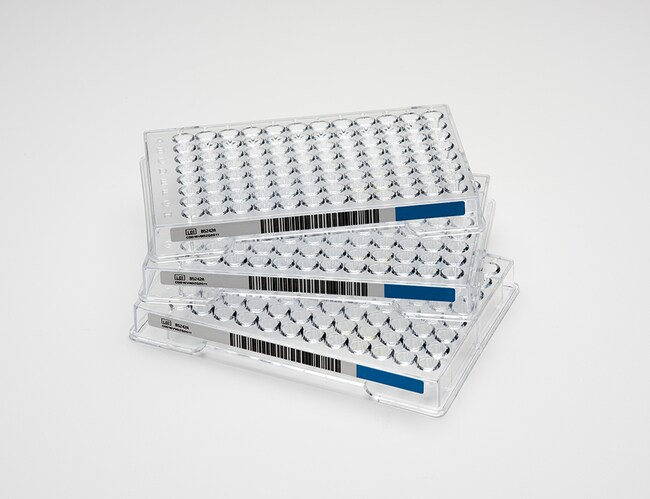Search Thermo Fisher Scientific
Thermo Scientific™
Sensititre™ SLOMYCO2 Susceptibility Testing Plate
Catalog number: SLOMYCO2

Thermo Scientific™
Sensititre™ SLOMYCO2 Susceptibility Testing Plate
Catalog number: SLOMYCO2
Perform susceptibility testing for slow growing mycobacterium species (SGM) using broth microdilution, the recommended method for Antimicrobial Susceptibility Testing. The Thermo Scientific™ Sensititre™ SLOMYCO2 plate offers scientists an updated (from SLOMYCO) plate format that aligns with recently updated guidelines for susceptibility testing of nontuberculous mycobacteria.
Gain MIC data for an extended range of relevant antibiotics. This updated format includes the addition of Clofazimine, an option now considered in multi-drug regimens associated with macrolide resistant SGM isolates.
| Antimicrobial Agents | Various |
| Description | Sensititre Myco Susceptibility Plate – Slow growing mycobacterium |
| Antibiotic Code | Various |
| Product Type | MIC Plate |
| Target Organism Class | Slow-growing Mycobacteria |
| Test Type | Minimum Inhibitory Concentration (MIC) |
| No. per Pack | 10 |
| Packaging Type | Box |
| Quantity | 10/Pk. |
| Unit Size | Each |
Showing 1 of 1
| Catalog Number | Specifications | Unit Size | Price (USD) | ||||||||||||||||||||||||||||||||||||||||||||||||||||||||||||||||||||||||||||||||||||||||||||||||||||||||||||||||||||
|---|---|---|---|---|---|---|---|---|---|---|---|---|---|---|---|---|---|---|---|---|---|---|---|---|---|---|---|---|---|---|---|---|---|---|---|---|---|---|---|---|---|---|---|---|---|---|---|---|---|---|---|---|---|---|---|---|---|---|---|---|---|---|---|---|---|---|---|---|---|---|---|---|---|---|---|---|---|---|---|---|---|---|---|---|---|---|---|---|---|---|---|---|---|---|---|---|---|---|---|---|---|---|---|---|---|---|---|---|---|---|---|---|---|---|---|---|---|---|---|
| SLOMYCO2 | Each | Request A Quote | |||||||||||||||||||||||||||||||||||||||||||||||||||||||||||||||||||||||||||||||||||||||||||||||||||||||||||||||||||||
| |||||||||||||||||||||||||||||||||||||||||||||||||||||||||||||||||||||||||||||||||||||||||||||||||||||||||||||||||||||||
Achieve reliable, consistent results for slowly growing non-tuberculosis mycobacteria isolates with Sensititre SLOMYCO2 AST Plate.
- Broth microdiltion (BMD) is the recommended AST method for mycobacteria
- Test Mycobacterium spp. including slowly growing Mycobacterium avium group, M. kansasii group or M. marinum group.
- Designed with reference to the latest CLSI advice on drug options and accompanying breakpoints (where set)
- BMD is a recommended AST method that maintains accurate results even where other methodologies fail
- Extended shelf life, room-temperature storage eliminates inventory control concerns
- Individual packaging allows the laboratory to test one plate at a time with no waste
- Inclusive on-scale QC ranges provide immediate quality assurance of testing methodology
- Easy set-up procedures and results in approximately 14 days for slow-growing organisms
- Test 12 antimicrobials on a single AST plate for cost-effective results
Thermo Fisher Scientific is a leader in providing AST solutions that help in the fight against antimicrobial resistance, offering high performance automated and manual test options and one of the largest, most up-to-date selections of antimicrobials for susceptibility testing.
The Sensititre System utilizes gold standard-level MIC accuracy1, providing superior quality and reproducibility for accurate results the first time. Broth microdilution is the reference method for AST, and in many cases 2 the most reliable phenotypic method to guide therapeutic decisions.For Research Use Only. Not for use in diagnostic procedures.
1. International Organization for Standardization (ISO) (2019) Susceptibility testing of infectious agents and evaluation of performance of antimicrobial susceptibility test devices — Part 1: Broth micro-dilution reference method for testing the in vitro activity of antimicrobial agents against rapidly growing aerobic bacteria involved in infectious diseases. ISO 20776-1:2019 2. EUCAST (2019) EUCAST reading guide for broth microdilution. Version 1. Accessed Nov 2019 http://www.eucast.org/fileadmin/src/media/PDFs/EUCAST_files/Disk_test_documents/2019_manuals/Reading_guide_BMD_v_1.0_2019.pdf “...for antimicrobial susceptibility testing of rapidly growing aerobic bacteria, except for mecillinam and fosfomycin, where agar dilution is the reference method.”
Figures
Documents & Downloads
Certificates
Search by lot number or partial lot number
Frequently asked questions (FAQs)
Citations & References
Search citations by name, author, journal title or abstract text